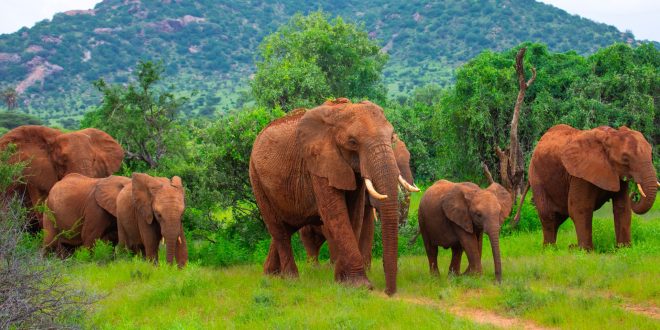In a remarkable experiment of artificial intelligence meets elephants, researchers have successfully demonstrated how the giant mammals call to each other using individual names.
According to a new study published in Nature Ecology and Evolution, African savannah elephants in Kenya were observed and listened to, using machine learning software called Elephant Voices which analysed calls being made between two herds of elephants.
The research took place in Samburu National Reserve and Amboseli National Park over four years including 14 months of fieldwork, in which elephants were tracked and observed and their “calls” recorded. Some 469 unique calls or “rumbles” were captured from the African elephants in the experiment.

What does the study reveal about the way elephants communicate?
It has long been known that elephants are highly social animals.
“The social network of elephants is incredibly rich, incredibly nuanced, and incredibly complex with this hierarchical structure of different types of relations and preferences and interactions,” George Wittemyer, behavioural ecologist at Colorado State University, one of the institutes involved in the Kenya study, told Al Jazeera.
Initial observations from researchers conducting the study in Kenya appeared to show that elephants were using a call-and-response system of communication. It had been noticed that matriarchs, the female leaders of elephant herds, would make a call, which sounded like a rumble, from within the group of elephants and the entire herd would respond.
However, shortly afterwards the same matriarch would give another, similar rumble and only one elephant far off from the group would give a response while hurriedly coming back to the group.
“And so in those cases, it’s just so obvious to the observer, to us on the ground, that something happened there that everybody in the group knew,” Wittemyer said. “The call was directed towards this other individual. That individual received and perceived that as well, responded and came to the group. And so you’re wondering, ‘are they using names?’”
The observations suggested that there might be a unique identifier embedded in the elephant rumbles that each elephant can recognise. These unique sounds are believed to be similar to how humans identify each other.
Wittemyer noted: “Maybe we greet each other with our names, but it’s not like we’re constantly using names with each other once we have each other’s attention, once we’re immersed in the conversation. And it seems like that’s probably the case with elephants as well.”
How were the elephant sounds recorded?
While humans are familiar with the loud trumpeting sound elephants make, some elephant sounds are infrasonic, meaning they use a frequency too low to be heard by humans. Therefore, specialised equipment was used to record and analyse the rumbles. “They’re using vocal cords and they’re producing these sounds, but the structure of those sounds is so different from ours,” Wittemyer explained.
Specialist AI learning software was used to identify specific, unique names being used in reference to particular elephants, occurring within the rumbles. Using this software, researchers were able to determine that names were being used in rumbles between elephants in nearly one-third (27.5 percent) of “calls”.
Identifying and understanding other parts of the rumbles would require additional research.
During the testing, researchers played a sound from a speaker that they believed was the “name” of an elephant, and the elephant would respond by picking up its head up, flapping its ears, while rumbling back as it walked towards the speaker.
In other instances, when the call from the speaker was not their “name”, the researchers found, the elephant might pick its head up, but the response was less active in a behavioural sense.
Do other animals use similar call signs?
Not exactly. While dolphins and parrots mimic the sounds of others in their species to address each other, elephants are the first non-human animals known to use unique names without relying on imitation.
In another report published last month by the journal Nature Communications, researchers analysed thousands of recorded calls made by sperm whales, revealing a “phonetic alphabet” within their sequences of “click” sounds. This discovery indicates that sperm whales use much more intricate communication systems, known as “codas”, than previously believed.
Unlike humpback whales which “sing”, sperm whales make clicking sounds, using a process known as echolocation whereby sound waves bounce off objects in the distance, returning to the whale so it can determine where the object is. Whales use echolocation to hunt and navigate the deep ocean.
 Top Naija News – Nigeria News, Nigerian News & Top Stories Top Naija News – Nigerian Newspapers, Nigerian News. topnaijanews is a daily Nigerian newspaper covering Latest News, Breaking News, Entertainment, Sports, Lifestyle and Politics.
Top Naija News – Nigeria News, Nigerian News & Top Stories Top Naija News – Nigerian Newspapers, Nigerian News. topnaijanews is a daily Nigerian newspaper covering Latest News, Breaking News, Entertainment, Sports, Lifestyle and Politics.




